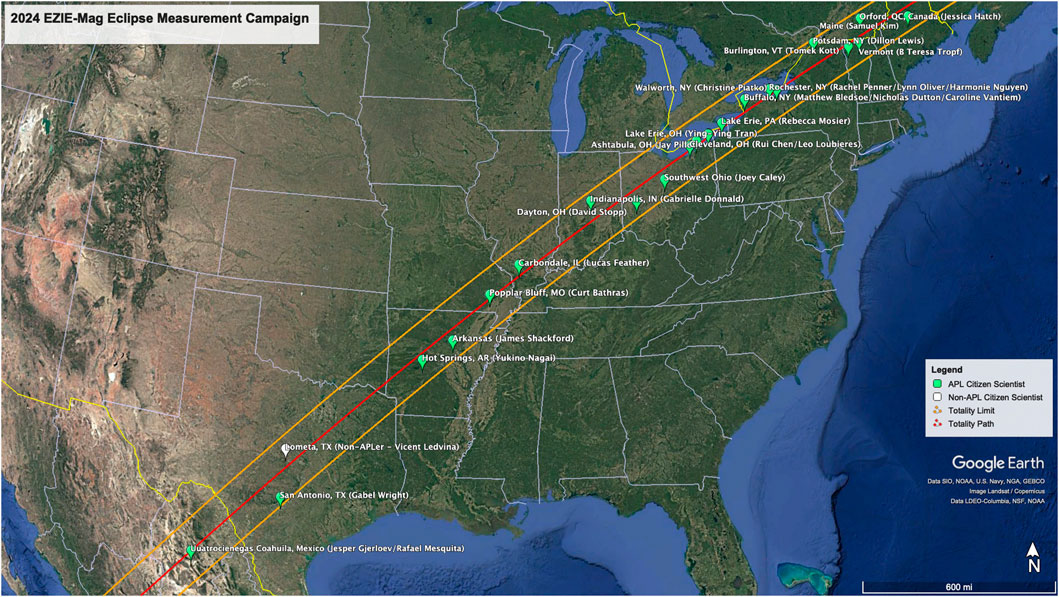- Johns Hopkins University Applied Physics Laboratory, Space Exploration Sector, Laurel, MD, United States
The 8 April 2024, total solar eclipse presented a unique opportunity to study ionospheric and magnetospheric responses to local changes in the solar illumination. As part of NASA’s citizen science initiative, we launched the EZIE-Mag Eclipse Measurement Campaign and deployed ultra low-cost, science-grade magnetometer kits operated by trained citizen scientists across diverse geographic locations. This grassroots decentralized approach enabled the collection of high-quality, distributed geomagnetic data. Observations from Muncie, Indiana, revealed a clear signal that is interpreted as being produced by eclipse-induced current system perturbations. This is an excellent example of complex electrodynamic coupling between the Sun and the magnetosphere-ionosphere-atmosphere environment. The results not only contribute to advancing Heliophysics research but also demonstrate the value of citizen science in enhancing space weather awareness and public education. The campaign’s inclusive approach in engaging participants from various backgrounds, underscores the potential for scalable, community-driven efforts to broaden participation and deepen public understanding of space weather phenomena.
1 Introduction
In 2023, NASA announced the Heliophysics Big Year activities related to the Sun’s influence on Earth and the solar system. The activities ranged from the Parker Solar Probe’s Closest Approach, to the 2023 Annular Eclipse and the 2024 Total Solar Eclipse. We took advantage of this development and the favorable path of the 2024 Total Solar Eclipse across North America to run a special campaign to capture the influence solar eclipses have on the ionospheric electric currents. We utilized an ultra low-cost, science-grade, and easy to operate magnetometer kit known as the EZIE-Mag. This magnetometer kit was developed as the outreach component of the NASA Electrojet Zeeman Imaging Explorer [EZIE, 9] mission. It is designed to have a simple assembly and focus on ease of deployment and operation.
Total solar eclipses are most known for the spectacular obscuration of the Sun by the moon that attracts millions of people to its path. It also leads to a large interest from a multitude of scientific communities. Beyond that, the decreases in the solar radiation leads to a cascade of phenomenon, some of which leading to changes in Earth’s ionospheric currents, including regional perturbations that may produce observable geomagnetic signatures.
The main objective of this paper is to share experiences we had in preparation and during the 2024 EZIE-Mag Total Solar Eclipse campaign. We introduce the scientific background that led to the development of these expected current perturbations. We then discuss the methodology, which includes citizen science participation, training, and the methods used to analyze the data. We show results of the data taken during the campaign. Finally, we discuss the results and share lessons learned from our campaign to help planning and deployments for future Solar Eclipses as well as other comprehensive campaigns utilizing large number of EZIE-Mags.
2 Science background
A total solar eclipse induces rapid and localized reductions in the solar radiation effects on Earth’s atmosphere. Mrak et al. (2018) showed the disturbance on the solar extreme ultra violet (EUV) and X-ray radiations, in addition to the visible light. They also showed the relationship between their obscuration model and the electrodynamics response to the eclipse with the total electron content morphology. A similar result was achieved by Coster et al. (2017) This reduction in plasma density decreases ionospheric conductivities, particularly in the E-region, where solar-driven ionization dominates. As conductivity drops, large-scale electrodynamic imbalances emerge. This modifies the polarization electric fields and the closure of magnetospheric currents along geomagnetic flux tubes (Huba and Drob, 2017).
Figure 1 shows the sequence of events that may produce ionospheric current perturbations. Following the rapid cooling of the thermosphere and decrease of ionospheric conductivity, electrodynamic responses may arise as the system seeks to maintain current continuity (Mrak et al., 2022; Clilverd et al., 2001). The effects of such current perturbations appear as a magnetic signature in the form of a fluctuation to the geomagnetic field (Ratnasari et al., 2024). The largest eclipse-related effects are likely to occur near regions with the strongest spatial gradients in ionospheric conductivity, which often, but not necessarily, coincide with the path of totality. With the physics of the event in mind and the general eclipse-related excitement, we based our citizen science campaign in the deployment of EZIE-Mag magnetometers along the totality path.
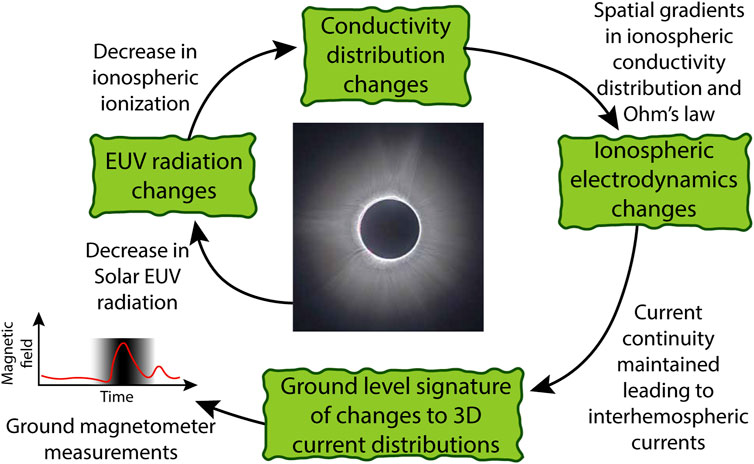
Figure 1. Cascade of processes leading to the ground-based measurements. Eclipse photo from Cincinnati, OH (Matthew Bailey).
3 Methodology
3.1 EZIE-Mag
Leading to the launch of the NASA EZIE satellite mission, NASA funded the EZIE team to launch the EZIE-Mag Citizen Science initiative. The project consisted in the developed an open-source, self-contained magnetometer kit that could be assembled and operated by middle and high school students. The kit utilizes Raspberry PI single board computers, which are a relatively new concept and act as the data processing unit for the system. The EZIE-Mag kits were also made possible by the development of the PNI RM3100 Magnetometer sensor board, which is a 3-Axis magnetometer with a theoretical maximum resolution of approximately 6.1 nT (1-
Figure 2 shows the parts needed to build an EZIE-Mag, the assembly onto the base plate, and the fully assembled instrument. These figures were adapted from the EZIE-Mag “Instructions for Assembly” manual, which is made available in the EZIE-Mag gateway. This open source manual contains instructions for assembling an EZIE-Mag. The steps are well described and are geared towards a middle-to high-school level of understanding and require minimal parental or educator supervision.

Figure 2. Images adapted from the EZIE-Mag “Instructions for Assembly” manual available in the EZIE-Mag gateway. From left to right: EZIE-Mag parts list, EZIE-Mag base plate assembled with all its components, and a fully assembled and sheltered EZIE-Mag.
The EZIE-Mag calibration and data processing workflow consists of six key steps to ensure accurate and calibrated magnetic field measurements. First, raw data sampled at 36 Hz is resampled to 1 Hz using boxcar averaging, ensuring reliable noise handling and efficient storage in hourly, daily, and weekly zip files. Next, temperature calibration is performed using a multi-linear correlation model that accounts for both absolute temperature and its temporal derivative, correcting the magnetic field components for thermal biases. The third step involves aligning the sensor’s z-axis to geographic down using data from the onboard accelerometer, which establishes a stable vertical reference. Subsequently, the horizontal components are rotated to align with local magnetic north and east based on PNI sensor data, following established methodologies by Gjerloev (2012) The data is then rotated into geographic coordinates using the International Geomagnetic Reference Field (IGRF) model, ensuring global consistency. This comprehensive approach ensures that citizen-collected data meets the standards necessary for robust geomagnetic research.
The intricate calibration process is tested and operational for long-term data analysis. However, given the transient eclipse experiment, the data shown in this paper cannot be calibrated. One of the major effects of the calibration aims to mitigate is the correlation between the temperature and the magnetic field measurements. Each instrument must operate for several days to enable an accurate calibration. While that was highly encouraged by our team to the citizen scientists, most of them traveled to the path of the eclipse for a very limited amount of time.
The citizen scientists were chosen based on their travel plans for the 8 April 2024 Total Solar Eclipse. A call for participants was sent to the Johns Hopkins University Applied Physics Laboratory staff (JHUAPL - where the corresponding author is employed). We allowed people from all backgrounds, including children of JHUAPL employees to sign up for participating in the measurement campaign. In the months prior to the eclipse, we gathered their basic information, and shared relevant training materials with simple instructions. The overarching goal was to get as much distribution along the path of totality as possible. We received
3.2 Citizen science training
Citizen scientists selected for the EZIE-Mag campaign underwent a structured training process to ensure engagement and readiness. From selection through kit delivery, participants received regular updates to keep them informed about campaign progress and the fundamentals of scientific measurement campaigns. One week prior to kit distribution, we provided an user guide (Figure 4) alongside simple operational guidelines to ensure straightforward deployment of the hardware.
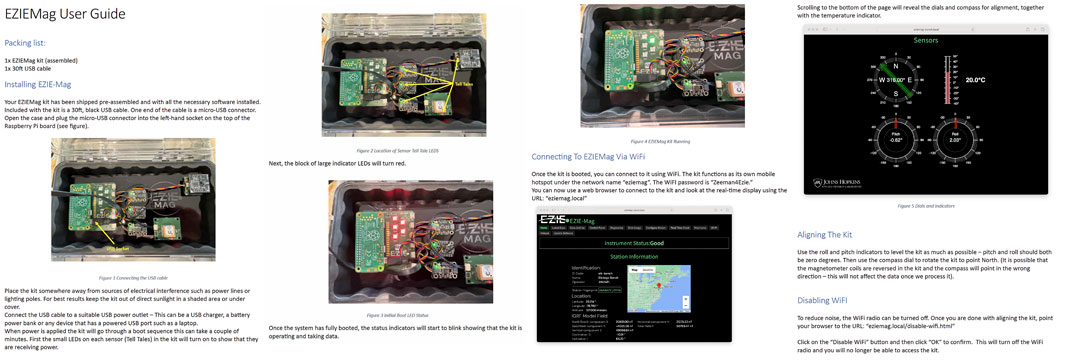
Figure 4. EZIE-Mag manual with instructions to successful deployment by citizen scientist during the EZIE-Mag Total Solar Eclipse Campaign.
The EZIE-Mag kits were designed for simplicity, requiring minimal effort to deploy and operate. Key deployment instructions included placing the unit on solid ground, ensuring a minimum 30-foot distance from sources of electromagnetic interference such as houses, air-conditioning units, vehicles, bicycles, or other machinery. To prevent thermal biases, participants were instructed to shield the unit from direct sunlight using non-magnetic, non-metallic materials like plastic coolers, flower pots, or even foliage. Participants were also advised to deploy magnetometers away from vehicles, power lines, and magnetic appliances.
The EZIE-Mag units use triaxial fluxgate magnetometers with a specified linear response within
Power options included either a standard 5V USB power bank, providing over 24 h of operation, or a direct USB power supply using a provided 30-foot micro-USB cord. Once powered, participants were advised to “start it and forget it,” allowing the unit to operate continuously for as long as possible; ideally beginning 24+ hours before and continuing well after the solar eclipse.
This approach ensured consistent, high-quality data collection while emphasizing the simplicity of the process, designed to be accessible even for individuals with minimal scientific or technical experience.
Lastly, the participants received in person one-on-one instructions from the campaign team. The questions they asked during that encounter were gathered and answered by email 2 days prior to the eclipse. Unfortunately, not every participant had the availability of a perfectly undisturbed deployment location. However, enough good quality data were collected to present meaningful scientific conclusions about the event.
4 Results
To illustrate the measurement capability we will focus on the measurements made in Muncie, Indiana, in the US. This was the EZIE-Mag with the longest uninterrupted period of observations during our campaign, with 3 days of measurements. Figure 5 shows the EZIE-Mag observations of total magnetic field and temperatures for April 7 and 8, 2024 (prior to and during the 2024 Total Solar Eclipse) from Muncie, Indiana.
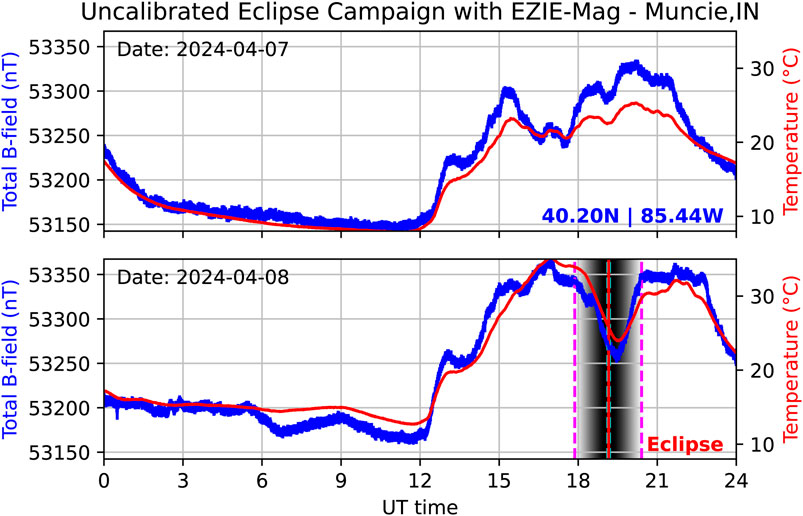
Figure 5. EZIE-Mag measurements of total magnetic field and temperatures for April 7 and 8, 2024, from Muncie, Indiana. The blue y-axis corresponds to the total magnetic field (blue line) and the red y-axis corresponds to the temperature (red line). The first and fourth contacts (C1 and C4) are highlighted in magenta, while the time in totality is highlighted at the center of the obscuration gradient in the figure. The uncertainty of EZIE-Mag, which is estimated to be
The first and most obvious finding is that the total magnetic field is visually correlated with the temperature. This effect can be accounted for in the process described in the methodology section of this manuscript. We use temperature measurements to find the possible temperature-related effects on the magnetic field. The goal here is not to provide the reader and the citizen science community with a detailed relationship between the eclipse-time and magnetic signatures measured by EZIE-Mag–we deem that out of scope of this manuscript. Another paper containing the results of this more intricate calibration is in production. Our purpose is simply to show that the passage of the eclipse appears to have a clear effect on the temperature and the total magnetic field, although at first glance it is unclear to what extent the magnetic field perturbations are related to changes in the overhead currents. As mentioned, another manuscript will be published to detail those findings. To show the presence of an eclipse-related magnetic signature, we normalize both the temperature and total magnetic field measurements with the same procedure. Figure 6 shows the normalized data from Figure 5. The correlation between temperature becomes even more evident with this figure, but the differences between the magnetic field curves and the temperature begin to appear.
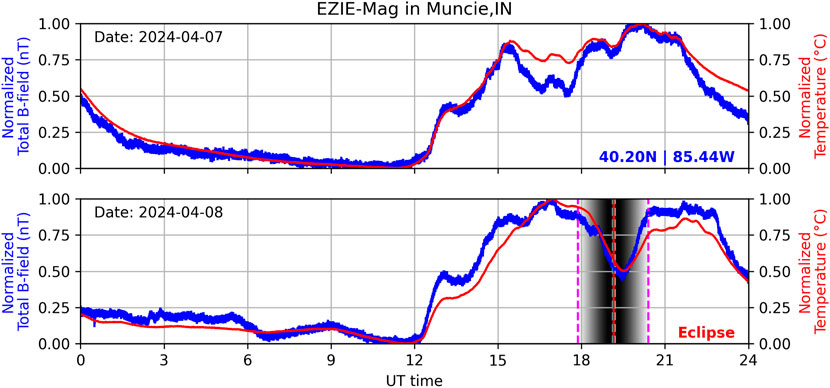
Figure 6. Normalized measurements corresponding to Figure 5. The blue y-axis corresponds to the normalized total magnetic field (blue line) and the red y-axis corresponds to the normalized temperature (red line). Both quantities have been normalized to their respective median and inter-quartile ranges. The uncertainty in the normalized magnetic field is proportional to the line thickness.
With the assumption that the magnetic field and temperature correlation is linear, we use the uncalibrated normalized curves of magnetic field and temperature shown in Figure 6 to calculate the residuals between these measurements. This is a good assumption given that the Pearson product-moment correlation coefficients for the data shown for temperature and magnetic field in Figure 5 is of 0.98. While the relationship is not expected to hold perfectly linear across all hours of the day, especially under rapidly changing environmental conditions of the solar eclipse, the linear model is used here as a first-order approximation. This simplification allows for the identification of residuals that may reflect geophysical signals not accounted for by local temperature effects. The normalized temperature minus the normalized total magnetic field is shown in Figure 7. Based on the assumption of linearity, the variations shown in this figure are mostly related to the magnetic field measurements.
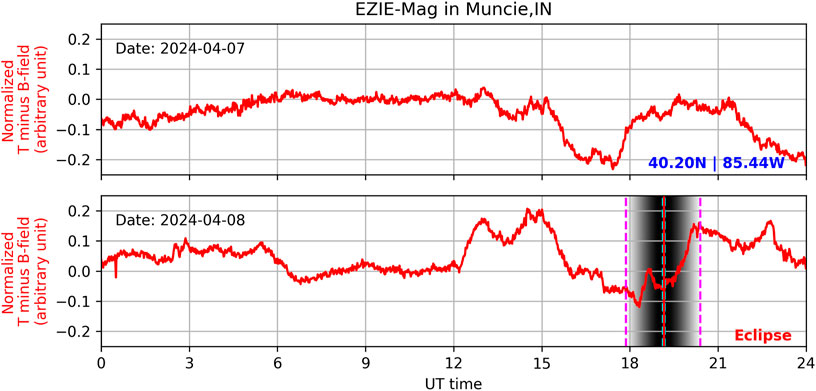
Figure 7. Residual between normalized total magnetic field and normalized temperature curves from Figure 6. The plotted quantity is defined as normalized temperature minus normalized magnetic field, and provides a first-order estimate of non-temperature-related magnetic variations.
Now to show the effects of the eclipse on the magnetic field measurements, we subtract the readings on day 7 from day 8. This assumes that day 7 gives a good representation of the magnetic baseline for day 8 or in other words, that the measurements on day 7 represents the typical daily variations. However, we argue that this approximation is good enough to show any eclipse effect on the ground magnetic field.
The very simple process described above and shown in Figures 5–8 portray the presence of an eclipse influence on the ground level magnetic fields, which may be attributed to changes in ionospheric electrodynamics during the event. While the exact source of the observed magnetic perturbations remains to be determined, the results suggest a link between the eclipse and transient modifications to current systems in the upper atmosphere. While some environmental noise is unavoidable, the consistency of the eclipse-time residual pattern and the absence of similar features on adjacent days support a geophysical origin. Future work will further quantify anthropogenic magnetic noise using shielded deployments and magnetic interference tests.
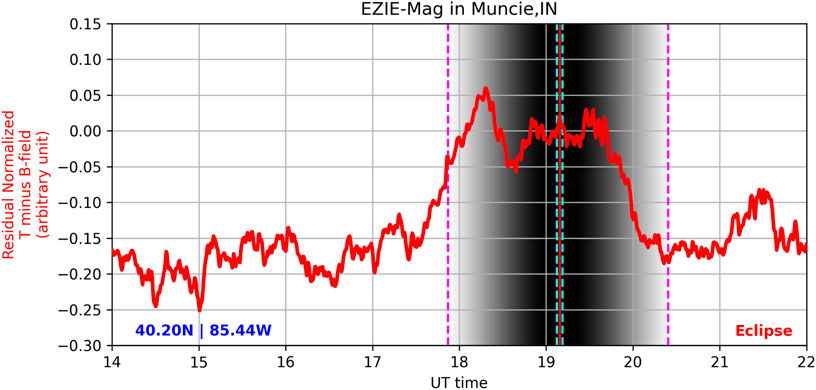
Figure 8. Final residual curve showing the difference between eclipse-day and control-day residuals from Figure 7. This aims to isolate the eclipse-related component of the magnetic field signal by subtracting baseline variability.
While this manuscript focuses on the high-quality, uninterrupted measurements from Muncie, Indiana, the EZIE-Mag campaign successfully deployed magnetometers at over a dozen sites across North America. Several of these sites recorded partial eclipse-time data showing qualitatively similar magnetic signatures. Due to variability in data quality, deployment conditions, and environmental noise, a full comparative analysis across sites is ongoing and will be reported in a follow-up study. Nonetheless, the spatial coverage afforded by this campaign provides a valuable resource, and all site data will be publicly available in the accompanying repository (Mesquita, 2025).
5 Discussion
The example observations shown in Figures 5–8, provide indications of eclipse-associated perturbations in the ground level magnetic fields. That highlights the influence of ionospheric dynamics on ground-based magnetometer measurements. Removing the temperature dependence reveals distinct magnetic signatures coinciding with the eclipse’s progression. While day-to-day geomagnetic variability introduces some uncertainty, the consistent residual patterns suggest the presence of eclipse-associated ionospheric currents, though the precise structure and origin of these currents remain undetermined. These findings underscore the value of low-cost, distributed magnetometer networks such as EZIE-Mag in capturing fairly small and transient current systems. The results also demonstrate how solar eclipses can serve as natural experiments to probe electrodynamic coupling processes between the Sun, ionosphere, and Earth’s magnetic field, advancing our understanding of solar-terrestrial interactions within Heliophysics research.
The EZIE-Mag Eclipse Measurement Campaign demonstrated the effectiveness and scientific value of citizen science-driven Heliophysics-related measurements. Leveraging a large network of engaged citizen scientists equipped with ultra low-cost, science-grade, EZIE-Mag magnetometers, the campaign successfully collected high-quality, distributed datasets during the 8 April 2024, total solar eclipse. The simplicity of the EZIE-Mag setup, combined with clear deployment guidelines and training, empowered participants to contribute meaningful observations with minimal technical barriers.
The successful detection of eclipse-related magnetic signatures, as evidenced by residuals that correlate with the eclipse timing, validates the capability of citizen-collected data to contribute to Heliophysics research without requiring extensive infrastructure. Our campaign also highlighted the importance of community engagement, both in gathering data and in fostering broader public understanding of space weather science. The decentralized approach also demonstrated logistical flexibility, with participants effectively deploying magnetometers across diverse environments while adhering to operational standards. This model of citizen science participation proved to be an efficient and scalable method for extending the reach of future scientific campaigns. That will offer valuable insights for Heliophysics initiatives and public outreach efforts in the future.
Our results and experiences gathered insights into the strengths and improvement areas for conducting citizen science-driven Heliophysics observation campaigns. One of our campaign’s greatest strengths was its decentralized approach, enabling widespread geographic coverage and diverse observational data. The effort was excellent in outreach, engaging participants from diverse background, and fostering broad-based high-level space weather science. The involvement of family and friends, including children, not only broadened participation but also enhanced public engagement and educational impact.
Even though the campaign was successful, our challenges included suboptimal deployment locations for some participants and the presence of non-geophysical magnetic perturbations caused by nearby electromagnetic interference, which impacted data quality of several datasets. To enhance future campaigns, improvements should include offering in-person training for participants including tips and tricks for operating the magnetometer, developing an informational video with general deployment guidelines, and ensuring the availability of a real-time support team to answer participant questions during deployment through a social media platform. These strategies would strengthen the scientific rigor and outreach impact of future citizen science initiatives.
6 Conclusion
The EZIE-Mag Eclipse Measurement Campaign utilized low-cost, citizen-operated magnetometers to observe magnetic field perturbations during the 8 April 2024, total solar eclipse, related to the NASA Heliophysics Big Year. The data acquired provided evidence of eclipse-induced ionospheric currents and demonstrated how citizen science efforts can contribute meaningful observations in geospace research. The campaign also highlighted the importance of community engagement and public education in space weather science. Based on our results, we conclude:
• Eclipse-induced perturbations in ground level magnetic field were observed, suggesting changes in the ionospheric currents during the event. The structure and origin of these currents remain an open question.
•Low-cost, decentralized magnetometer networks like EZIE-Mag are effective tools for detecting transient geophysical phenomena.
•Citizen science participation provided high-quality data and fostered broader public engagement in Heliophysics research.
•Key strengths included the simplicity of deployment, wide geographic coverage, and the educational value of involving participants with diverse background.
•Challenges included suboptimal deployment locations and magnetic interference from nearby environmental sources.
•Future campaigns can be improved with in-person training, the creation of informational videos, and real-time support for participants.
•The EZIE-Mag campaign offers a scalable model for future citizen science efforts in Heliophysics and space weather research.
Data availability statement
The full dataset from the 2024 EZIE-Mag Solar Eclipse Campaign, including calibrated and raw magnetic field measurements from all participating stations, is publicly available at https://doi.org/10.5281/zenodo.15992827 (Mesquita, 2025).
Ethics statement
The patients/participants provided written informed consent to participate in this study.
Author contributions
RM: Visualization, Formal Analysis, Software, Writing – original draft, Data curation, Resources, Validation, Funding acquisition, Methodology, Conceptualization, Investigation, Supervision, Writing – review and editing, Project administration. RB: Data curation, Resources, Supervision, Methodology, Writing – review and editing, Software, Writing – original draft. JG: Writing – original draft, Methodology, Visualization, Resources, Data curation, Investigation, Conceptualization, Writing – review and editing, Software, Funding acquisition. AE: Software, Writing – original draft, Resources, Writing – review and editing, Methodology. NM: Writing – original draft, Writing – review and editing, Resources, Funding acquisition, Supervision. RE: Data curation, Writing – original draft, Writing – review and editing, Resources.
Funding
The author(s) declare that financial support was received for the research and/or publication of this article. The EZIE-Mag project serves as the outreach component of the EZIE Mission, which is funded by NASA’s Science Mission Directorate (SMD) under the Heliophysics Division (HPD). RM would like to acknowledge the NASA Grant 80NSSC23K0094 in the preparation of this paper.
Acknowledgments
We are grateful for the 2024 EZIE-Mag Total Solar Eclipse Campaign citizen scientists for their dedication and invaluable contributions. Special thanks go to Arnav Agrawal, Mathew Bledsoe, Joey Caley, Rui Chen, Peter Chi, Joshua Douty, Nicholas Dutton, Marc Hoffman, Samuel Kim, Rebecca Mosier, Hari Nair, Colleen O’Shea, Todd and Lynn Oliver, Christine Piatko, Ryan Poffenbarger, Jimmy Shackford, and David Stoppfor, for their efforts and support throughout the campaign.
Conflict of interest
The authors declare that the research was conducted in the absence of any commercial or financial relationships that could be construed as a potential conflict of interest.
Generative AI statement
The author(s) declare that no Generative AI was used in the creation of this manuscript.
Publisher’s note
All claims expressed in this article are solely those of the authors and do not necessarily represent those of their affiliated organizations, or those of the publisher, the editors and the reviewers. Any product that may be evaluated in this article, or claim that may be made by its manufacturer, is not guaranteed or endorsed by the publisher.
References
Clilverd, M. A., Rodger, C. J., Thomson, N. R., Lichtenberger, J., Steinbach, P., Cannon, P., et al. (2001). Total solar eclipse effects on vlf signals: observations and modeling. Radio Sci. 36, 773–788. doi:10.1029/2000rs002395
Coster, A. J., Goncharenko, L., Zhang, S.-R., Erickson, P. J., Rideout, W., and Vierinen, J. (2017). Gnss observations of ionospheric variations during the 21 August 2017 solar eclipse. Geophys. Res. Lett. 44, 12–041. doi:10.1002/2017gl075774
Gjerloev, J. (2012). The supermag data processing technique. J. Geophys. Res. Space Phys. 117. doi:10.1029/2012ja017683
Huba, J., and Drob, D. (2017). Sami3 prediction of the impact of the 21 August 2017 total solar eclipse on the ionosphere/plasmasphere system. Geophys. Res. Lett. 44, 5928–5935. doi:10.1002/2017gl073549
Mesquita, R. (2025). Eclipse-induced geomagnetic signatures: the 2024 ezie-mag citizen science campaign contribution to the heliophysics big year. doi:10.5281/zenodo.15998917
Mrak, S., Semeter, J., Drob, D., and Huba, J. (2018). Direct euv/x-ray modulation of the ionosphere during the August 2017 total solar eclipse. Geophys. Res. Lett. 45, 3820–3828. doi:10.1029/2017gl076771
Mrak, S., Huba, J., Krall, J., and Drob, D. (2022). Modeling the effects of a total solar eclipse on ionospheric electrodynamics using sami3/esf. Adv. Space Res. doi:10.1016/j.asr.2022.11.010
Ratnasari, E. A., Ruhimat, M., Nuraeni, F., Yatini, C. Y., Biantoro, M. A. A., and Tanesib, J. L. (2024). “Geomagnetic field effect observed in biak during the solar eclipse of April 20, 2023,” in International seminar on aerospace science and technology (Springer), 248–255.
Yee, J.-H., Gjerloev, J., Perez, R., Swartz, W. H., Misra, S., Chidambaram, O., et al. (2021). “The ezie way to measure the ionospheric electrojets with a three-cubesat constellation,” in 35th annual AIAA/USU conference on small satellites (Logan, UT: Utah State University). Available online at: https://digitalcommons.usu.edu/smallsat/2021/all2021/177/.
Keywords: space weather, citizen science, EZIE-Mag, magnetometry, ionospheric currents, eclipse, Heliophysics Big Year
Citation: Mesquita RLA, Barnes R, Gjerloev J, Eisape A, Mosavi N and Eidson R (2025) Eclipse-induced geomagnetic signatures: the 2024 EZIE-Mag citizen science campaign contribution to the Heliophysics Big Year. Front. Astron. Space Sci. 12:1601396. doi: 10.3389/fspas.2025.1601396
Received: 28 March 2025; Accepted: 28 July 2025;
Published: 13 August 2025.
Edited by:
Hyunju Kim Connor, National Aeronautics and Space Administration, United StatesReviewed by:
Zhonghua Xu, Virginia Tech, United StatesGang Kai Poh, The Catholic University of America, United States
Copyright © 2025 Mesquita, Barnes, Gjerloev, Eisape, Mosavi, Eidson and EZIE-Mag team. This is an open-access article distributed under the terms of the Creative Commons Attribution License (CC BY). The use, distribution or reproduction in other forums is permitted, provided the original author(s) and the copyright owner(s) are credited and that the original publication in this journal is cited, in accordance with accepted academic practice. No use, distribution or reproduction is permitted which does not comply with these terms.
*Correspondence: Rafael L. A. Mesquita, cmFmYWVsLm1lc3F1aXRhQGpodWFwbC5lZHU=
 Rafael L. A. Mesquita
Rafael L. A. Mesquita Robin Barnes
Robin Barnes Jesper Gjerloev
Jesper Gjerloev